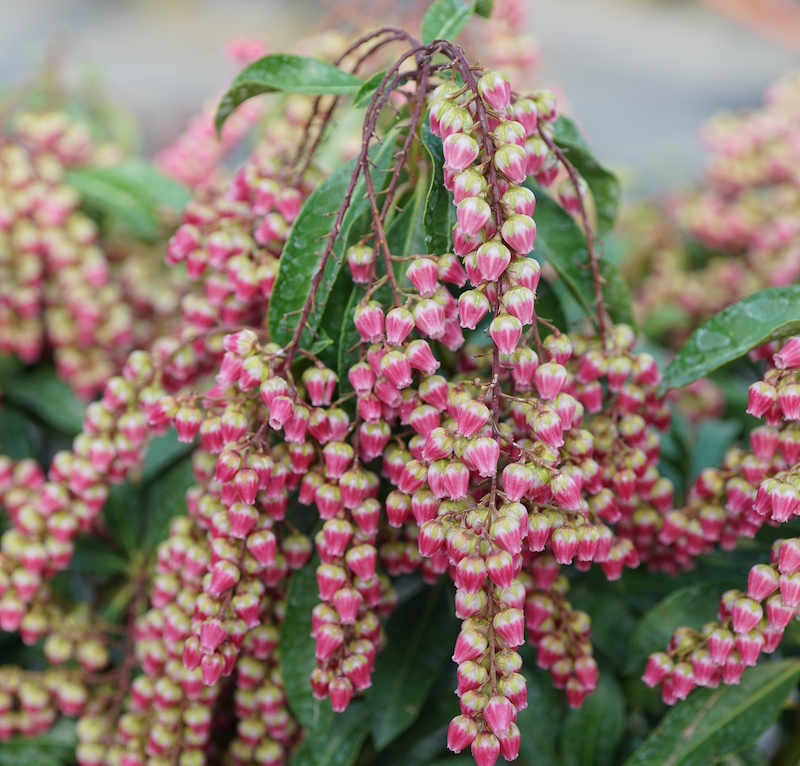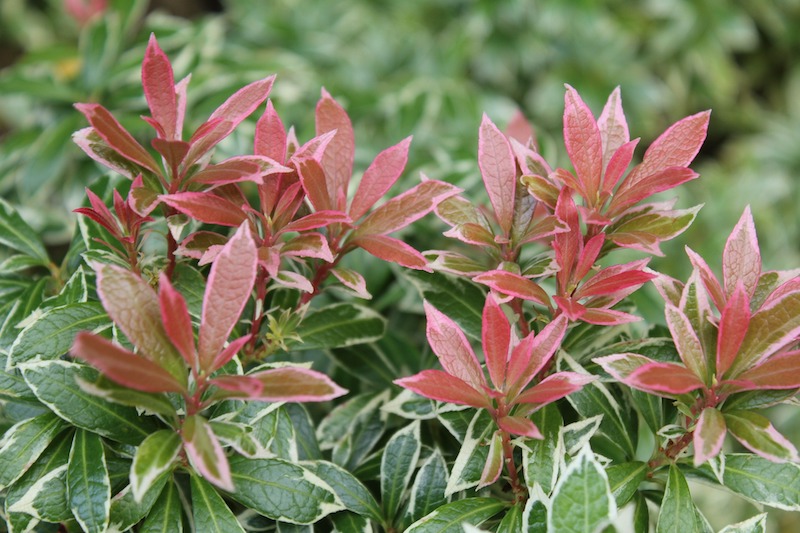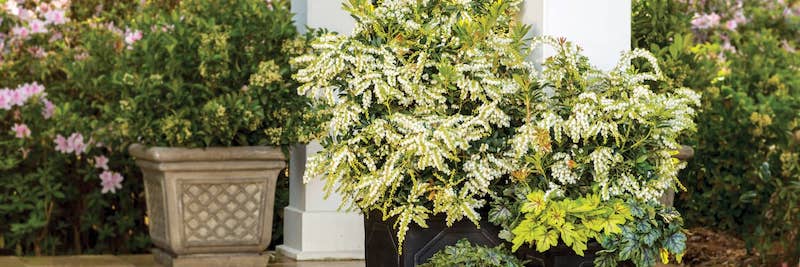Pieris Japonica is a broadleaf evergreen shrub that is available in a wide variety of sizes. They range from shrubs that are good for groundcovers at 10 inches tall to giants that are well over 6 feet in height and spread. Most parts of the United States can grow Pieris successfully with little winter maintenance. Pieris provides the perfect backdrop for smaller plants as it has year-round interest.
The leaves turn brilliant colors of red, orange, and pink both in the fall and in the spring as the new growth emerges. The flower display in the spring makes a lovely backdrop for other spring bulbs. Pieris can be added to just about any garden plan, from a cottage garden to an Asian-inspired zen garden.

Planting Pieris
Pieris prefers to have a part-sun position in the garden. Full sun in the early morning is also suitable, as long as the shrub is protected at the hottest part of the day. Pieris is an acid-loving plant and requires a pH between 5.0-6.5. Good-draining soil is a must to prevent root rot. Mulching on a regular basis can help to bulk the soil up as well as make the soil around Pieris more moisture retentive. Mulching with pine straw or organic compost will help to reinforce a soil that is naturally on the acid side. When Pieris is well established it can be a drought-tolerant shrub that provides many years of enjoyment.

Watering Pieris
Broadleaf evergreen shrubs can become drought tolerant after they mature, requiring only supplemental watering once a week to every 10 days. When they are newly planted, Pieris and other shrubs will need watering more often until their root systems are fully developed to support all of their top growth. In order to encourage the root systems to grow deep in the soil, where they are not as susceptible to the effects of the weather, weekly watering needs to be broken into 2-3 longer sessions. Pieris needs about 1 inch of water a week.
Many shorter watering sessions will encourage the roots to grow close to the surface of the soil where they will dry out and be stressed more quickly from the weather. Watering with low-impact devices such as drip irrigation lines or soaker hoses will put the water right at the root zone where the plant needs it the most. Overhead watering with a wand or oscillating sprinkler results in a large percentage of the water being lost to evaporation.
Fertilizing Pieris
Pieris is an ornamental shrub and is bred to have certain attributes, such as bloom color, leaf color, and mature size. In order to maintain vigorous growth and brilliant colors, a slow-release fertilizer formulated for acid-loving plants needs to be applied on an annual basis. A complete fertilizer will have the right blend of macro and micronutrients to support growth in acid soils.
Slow-release fertilizers are best applied once at the beginning of spring when the new growth starts. Plants are not able to use fertilizers when they are semi or completely dormant in the winter. Applying feeds late in the fall as the plant prepares for winter can do more harm to the plant and may be washed away over the winter.
Pruning Pieris
Pruning Pieris is easy and is done mainly to keep the shrub healthy. Winter maintenance pruning is done in the late winter or early spring to remove any damaged parts from the winter. Carefully cut around the flower buds in spring. Deadheading at the end of the bloom time will help Pieris make way for vigorous new growth and setting of next year's flower buds. Pieris also will regrow heartily from rejuvenation pruning done in early spring. Rejuvenation pruning is done to correct poor pruning practices or to jump-start a shrub that is starting to decline in vigor.
Caring For Pieris in Pots
Pieris can quite happily grow in containers and make a great anchor in a seasonal mixed planting of rotating annuals or bulbs. Many sizes of pieris are available to fit any container. Pieris also will grow to fit their container and slow down their growth while potted. Pieris planted as a specimen should be in at least a 5-gallon container (about 12 inches in diameter). Larger Pieris planted with other annuals or bulbs need to be in 18-inch diameter and larger containers. Regular fertilizing and sometimes daily watering will be needed for pot-grown Pieris.

Winter Care for Pieris
Broadleaf Evergreens are easy to take care of over the winter with little extra attention. Monitor drainage of the garden soil or the pot to make sure that Pieris is not standing in cold, waterlogged soils. The roots of broadleaf evergreens will not survive in boggy soil, and the plant will fail to put on new growth in the spring. Pots that are getting too much water are easily moved to a more sheltered position until spring.
Shrubs in the ground are more difficult to move and might not even survive a temporary transplanting to a pot for the rest of the winter. The only thing to do in that case is to wait until spring and amend the location for better drainage, or transplant to a completely different part of the garden with better year-round drainage.
Common Care Questions About Pieris
How Do You Rejuvenate Pieris?
If Pieris becomes very large and/or overgrown or unruly and has many damaged, crossed, or diseases branches, sometimes the best way to rejuvenate them is to give them a good, hard pruning. Cutting them back by 1/3 or even back to old wood can help. Be aware that hard pruning may be at the cost of next year's blooms, and perhaps even the next year, in some cases.
Why Are My Pieris Leaves Drooping?
Drooping leaves on Pieris are likely from under-watering or soil that is too alkaline. Be careful to not over-water but keep the well-draining soil consistently moist and provide soil or growing medium that is slightly acidic and an adequate amount of sunlight.
What Causes Yellow Leaves On Pieris?
Yellowed leaves on Pieris are often the result of roots damaged by over-watering or soil that doesn't drain well, leaving them unable to absorb nutrients.
What Kind Of Soil Do Pieris Prefer?
Pieris prefer, and thrive in loose soils that drain well, and are acidic. If necessary, soil amendments should keep the pH levels between 5 and 6.
Can Pieris Grow In Shade?
While Pieris prefer to be planted in full sun or partial shade, they can do well in full shade but will not produce as many flowers.
Should Pieris Be Deadheaded?
Deadheading Pieris isn't necessarily required, it can certainly help to promote additional healthy new growth and root development.
How Long Do Pieris Blooms Last?
Pieris' bloom for about 2 or 3 weeks, in spring.
Is Pieris Edible?
Pieris plants are toxic to animals and humans alike. If either leaves or flowers are ingested, symptoms may include but are not limited to vomiting, diarrhea, low blood pressure, hypersalivation, and coma.
Is Pieris Invasive?
Pieris are non-invasive.
Is Pieris An Annual Or Perennial?
Pieris are an evergreen, broadleaf shrub.
Why Are Pieris Leaves Turning Yellow, Brown, and/or Black?
Spots on Pieris leaves that are brown, or a light shade of brown, with dark edges, can be caused by Leaf Spot fungal infections such as Alternaria and Phyllosticta. Conditions that promote the fungus are crowding, weak, stressed, and plants in hot, humid areas. Removing and disposing of infected foliage and branches, improving air circulation, removal of any debris around the plants, and avoiding watering from above can help keep these under control, and are also preventative measures. Application of fungicide may also be necessary.
What Is The Growth Rate of Pieris?
Pieris are generally considered to be slow growing and may gain less than 12 inches annually.
Is Pieris Drought Tolerant?
Once they're established, Pieris is relatively tolerant of drought and dry conditions, though of course, they perform better with regular moisture.
Have a question about Pieris? Fill out the form below and we will try and get back to your question as soon as possible. We may even feature your question in this article to help other gardeners!
 |
Author Robbin Small - Published 8-11-2022 |
